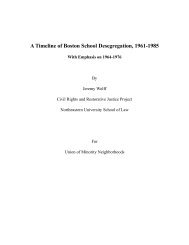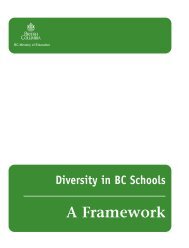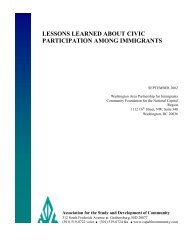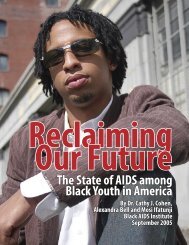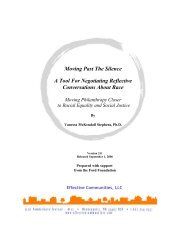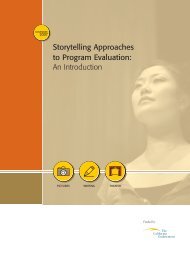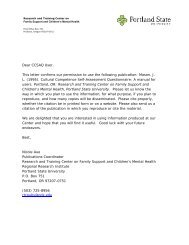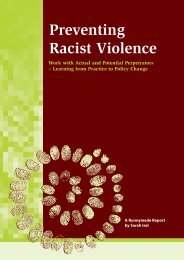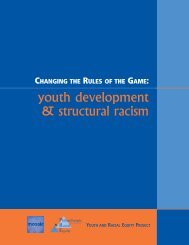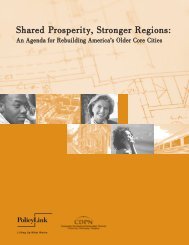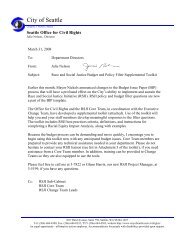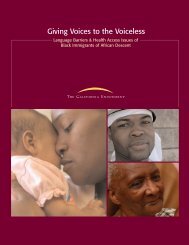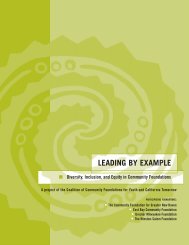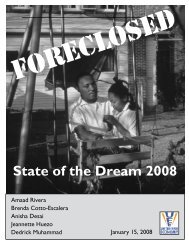Stories of Philanthropic Leadership in Advancing Regional and ...
Stories of Philanthropic Leadership in Advancing Regional and ...
Stories of Philanthropic Leadership in Advancing Regional and ...
Create successful ePaper yourself
Turn your PDF publications into a flip-book with our unique Google optimized e-Paper software.
REGIONAL OPPORTUNITYIn 2001, thanks to Fruitvale Ma<strong>in</strong> Streets’ leadership,the district’s commercial property owners adopted aBus<strong>in</strong>ess Improvement District (BID), throughwhich property owners pay an assessment for TheUnity Council to provide enhanced safety <strong>and</strong>cleanl<strong>in</strong>ess services. Accord<strong>in</strong>g to the Council’sexecutive director, Marsha Murr<strong>in</strong>gton, the BIDgenerates about $220,000 per year, pay<strong>in</strong>g for dailycleanup <strong>and</strong> for graffiti abatement. These activitiesimprove local bus<strong>in</strong>esses’ ability to attract customers.The Unity Council saw the BID as a greatopportunity to create jobs for its workforcedevelopment clients. It hired several clients to cleanthe Fruitvale commercial district <strong>and</strong> to serve asAmbassadors (a community based, uniformedpatrol). This later grew <strong>in</strong>to a public spacema<strong>in</strong>tenance bus<strong>in</strong>ess, with 12 full-time clean<strong>in</strong>gstaff <strong>and</strong> two Ambassadors, that has successfully bidon other contract<strong>in</strong>g opportunities.ResultsAccord<strong>in</strong>g to the Ford Foundation’s Anthony,regional equity <strong>in</strong>volves connect<strong>in</strong>g marg<strong>in</strong>alizedcommunities to regional opportunities. Byconv<strong>in</strong>c<strong>in</strong>g the MTA to extend the Second AvenueSubway through East Harlem, RPA <strong>and</strong> its allies arehelp<strong>in</strong>g establish anew regional<strong>Regional</strong> equity <strong>in</strong>volves connection for EastHarlem residents.connect<strong>in</strong>g marg<strong>in</strong>alizedThis connectivitycommunities to regionalwas furtheropportunities.enhanced by RPA’ssuccessful advocacyfor a station at 116 thAvenue. Through the workshops <strong>and</strong> the Work<strong>in</strong>gGroup, RPA has worked with the community todesign stations that would serve <strong>and</strong> support the EastHarlem community with <strong>in</strong>creased hous<strong>in</strong>g <strong>and</strong>economic opportunities. Through the Work<strong>in</strong>gGroup <strong>and</strong> its streetscape plann<strong>in</strong>g activities, RPAhelped to build the capacity <strong>of</strong> community <strong>in</strong>tereststo have <strong>and</strong> build a long-term vision for EastHarlem. In addition, the RPA l<strong>in</strong>ked thesecommunity <strong>in</strong>terests with regional agencies. Inpartnership with the East Harlem community, RPAhas built a model for community-based plann<strong>in</strong>gthat can be replicated as future transportation<strong>in</strong>vestments occur throughout the New York Cityregion, ensur<strong>in</strong>g that commitments to jobs, hous<strong>in</strong>g,<strong>and</strong> transportation access persist.Similarly, positive results <strong>of</strong> the Fruitvale Ma<strong>in</strong> StreetProgram were identified by LISC’s Forbes. S<strong>in</strong>ce the<strong>in</strong>ception <strong>of</strong> Fruitvale Ma<strong>in</strong> Street Program, 268 netnew jobs <strong>and</strong> 76 net new bus<strong>in</strong>esses have been created<strong>in</strong> the Fruitvale commercial district. Over 115 façadeimprovements have occurred. The Bus<strong>in</strong>essImprovement District (BID) was described as asignificant result <strong>in</strong> itself—LISC provided thetechnical assistance on how to start a BID, <strong>and</strong>provided fund<strong>in</strong>g for a consultant to actually establishthe BID. Even more, the Ma<strong>in</strong> Street program <strong>and</strong>the BID had dramatic impacts on InternationalBoulevard <strong>and</strong> the surround<strong>in</strong>g Fruitvale community.For example, International Boulevard saw doubledigit commercial vacancy rates <strong>in</strong> the 1990s <strong>and</strong>today the rates st<strong>and</strong> at effectively zero.Lessons LearnedAccord<strong>in</strong>g to Ford’s Anthony, “Communitymembers, particularly those most at risk <strong>of</strong>displacement, must have specific, consistent, <strong>and</strong>culturally appropriate opportunities to access <strong>and</strong><strong>in</strong>fluence the plann<strong>in</strong>g <strong>of</strong> any specific TOD.Affordable hous<strong>in</strong>g should be <strong>in</strong>tegrated <strong>in</strong>to anynew transit-oriented development, pay<strong>in</strong>g particularattention to <strong>in</strong>come levels <strong>in</strong> the surround<strong>in</strong>gneighborhoods. Bus<strong>in</strong>ess <strong>and</strong> economic developmentopportunities for local residents <strong>and</strong> entrepreneursshould be <strong>in</strong>corporated <strong>in</strong>to the plann<strong>in</strong>g,construction, <strong>and</strong> operation <strong>of</strong> any new TOD.Aga<strong>in</strong>, community <strong>in</strong>volvement is fundamental, butnot only at the project-specific level.” Anthonypo<strong>in</strong>ts out that the East Harlem Community L<strong>in</strong>kInitiative demonstrates that community <strong>in</strong>terestsmust engage the regional decisionmak<strong>in</strong>g processes<strong>and</strong> its practitioners to best ensure that any newTOD becomes a true community asset.The lessons for LISC <strong>and</strong> other funders <strong>of</strong> The UnityCouncil’s Fruitvale Transit Village are thatcommercial corridor revitalization programs arecomplex <strong>and</strong> each urban community has its ownchallenges <strong>and</strong> opportunities. Thus, a commercialcorridor revitalization program needs to be developedslowly, specifically based on the local community’sneeds. Because each community is different,provid<strong>in</strong>g technical assistance toward commercialcorridor revitalization “requires a toolkit with manydifferent tools,” expla<strong>in</strong>s Sheila Daniels, program105Funders’ Network for Smart Growth <strong>and</strong> Livable Communities



